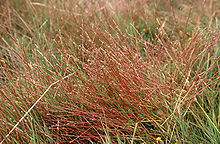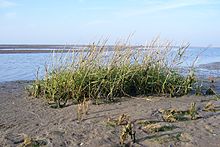Charles Edward Hubbard
Charles Edward Hubbard (1900–1980) was a British botanist, specialising in agrostology – the study of grasses; he was considered "the world authority on the classification and recognition of grasses".[1] He is indicated by the author abbreviation C.E.Hubb. when citing a botanical name.[2]
Biography


Charles Edward Hubbard was born on 23 May 1900 in Appleton, a hamlet on the Sandringham Estate in Norfolk, where his father, also named Charled Edward Hubbard, was the head gardener at Appleton House to the queen of Norway.[1] He was schooled at Sandringham, and at King Edward VII Grammar School in King's Lynn, before joining the staff of the Royal Gardens at Sandringham in 1916.[1] During his time there, he also spent five months at the Bygdøy Royal Estate near Oslo, and served for seven months in the Royal Air Force.[1]
In April 1920, Hubbard left the Sandringham Estate to join the Royal Botanic Gardens, Kew, initially working in the temperate house and arboretum.[1] In September 1922, he gained a position in the herbarium, working at first under Stephen Troyte Dunn, and later under Otto Stapf.[1] Hubbard published his first scientific paper in 1925, describing two new species in the genus Stipa.[1] In 1927, he married Madeleine Grace Witham, with whom he fathered a son, John.[1]
At the request of the Government of Queensland, Hubbard travelled to Australia in 1930, in exchange for the Australian botanist W. D. Francis, who spent a year at Kew.[3] He visited the herbaria in Sydney, Melbourne, Adelaide and Perth,[1] as well as examining every grass specimen in the Queensland Herbarium in Brisbane.[3] He carried out field work around Rockhampton and the Fitzroy River in central Queensland, accumulating 15,000 specimens.[3]
During the Second World War, the Kew herbarium was evacuated to Oxford and Hubbard moved with it, keeping his British herbarium at 9 Crick Road, the former residence of George Claridge Druce, while the Kew herbarium was housed in the basement of the Bodleian Library.[1]
On 1 October 1957, Hubbard was promoted to Keeper of the Herbarium and Library at Kew, and rose to Deputy Director in April 1959. His first wife died in 1961. and in 1963, Hubbard married Florence Kate Hubbard, his second cousin by marriage.[1] On 30 November 1965, he retired and moved to Hampton, Middlesex, close to Kew.[1] He died on 8 May 1980.[1]
Work
Hubbard published a long series of scientific articles, chiefly on the grasses of Europe and tropical Africa, but also covering the grasses of the West Indies, Mauritius, Malaya and Fiji.[1] He is perhaps better remembered for his popular science book Grasses: a Guide to their Structure, Identification, Uses and Distribution in the British Isles, published in 1954, with a second edition following in 1968.[1]
Accolades
Hubbard was the recipient of a number of awards, including the OBE (1954), CBE (1965), the Linnean Gold Medal (1967) and the Veitch Memorial Medal (1970). He was also awarded a D.Sc. degree honoris causa by the University of Reading (1960).[1] A number of botanical names commemorate Hubbard, including Acacia hubbardiana,[3] Digitaria hubbardii,[3] Hubbardochloa[4] (and thus also the subtribe Hubbardochloinae),[5] Hubbardia (and thus also the tribe Hubbardieae)[6] and Pandanus hubbardii.[7]
References
- ^ a b c d e f g h i j k l m n o p J. P. M. Brenan (1981). "Dr. Charles Edward Hubbard, C.B.E. (1900–1980)". Kew Bulletin. 36 (3): 437–440. JSTOR 4117577.
- ^ "Hubbard, Charles Edward (1900-1980)". International Plant Names Index. 2005. Retrieved 13 February 2011.
- ^ a b c d e "Hubbard, Charles Edward (1900–1980)". Biography. Australian National Herbarium. 13 November 2007. Retrieved 13 February 2011.
- ^ David Gledhill (2008). The Names of Plants (4th ed.). Cambridge University Press. ISBN 978-0-521-86645-3.
- ^ P. Auquier (1980). "Hubbardochloa, a new genus of grasses from Rwanda and Burundi". Bulletin du Jardin botanique national de Belgique / Bulletin van de National Plantentuin van België. 50 (1/2): 241–247. JSTOR 3667787.
- ^ S. R. Yadav, A. N. Chandore, S. M. Gund, M. Nandikar & M. Lekhak (2010). "Relocation of Hubbardia heptaneuron Bor, from its type locality" (PDF). Current Science. 98 (7): 884.
{{cite journal}}: CS1 maint: multiple names: authors list (link) - ^ Harold St. John (1969). "Revision of the genus Pandanus Stickman, Part 33. Further accounts of Australian species, and a key to the section Microstigma". Pacific Science. 23 (1): 89–114. hdl:10125/3371.
